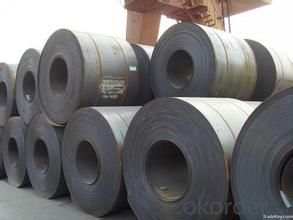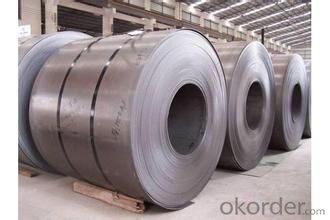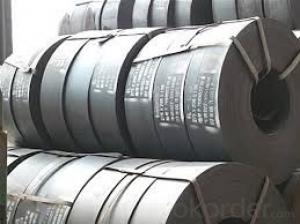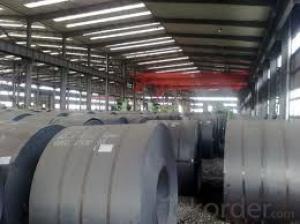hot rolled steel coil DIN 17100 in good Quality in China
- Loading Port:
- Tianjin
- Payment Terms:
- TT OR LC
- Min Order Qty:
- 100 m.t.
- Supply Capability:
- 500000 m.t./month
OKorder Service Pledge
OKorder Financial Service
You Might Also Like
Description:
Hot-Rolled Steel Sheets and Coils are applied to a wide range of uses such as automobile, electrical appliance, m achinery manufacturing, container manufacturing, shipbuilding, bridge, pipeline, and receive high acclaim from our customers for its excellent quality.
Specification
Product: | Hot Rolled Steel Coils/Sheets |
Material: | Q195,Q235,A36,SS400,S235JR,Q345,ST37-2, CCSB etc |
Standard : | JIS G3002 GB/T251B |
Technique: | hot rolled |
Thickness | 1.2mm to 200mm |
Tolerance of thickness: | :+/-0.03mm |
Width: | 750mm-2000mm |
Tolerance of width: | :+/-5.00mm (aiming to +/-2.00mm) |
Normal width: | 914mm, 1000mm, 1200mm, 1219mm, 1250mm,1500mm |
Length: | According to requirement |
Coil ID: | 508mm-610mm |
Coil Weight: | 10-25 Metric Tons |
Surface: | Black, Chromate, fingerprint resistant treatment, slight oiled or non-oiled, dry |
Port of Loading: | Tianjin/Shanghai port |
Packaging Details: | Standard export packing or according to the clients required |
Delivery Time | Within 30 days after received 30% deposit or workable L/C |
Payment Terms: | L/C,T/T |
Image:


We can ensure that stable quality standards are maintained, strictly meeting both market requirements and customers’ expectations. Our products enjoy an excellent reputation and have been exported to Europe, South-America, the Middle-East, Southeast-Asia, Africa and Russia etc.. We sincerely hope to establish good and long-term business relationship with your esteemed company.
- Q:How are steel coils used in the production of metal signage?
- Steel coils are an essential component in the production of metal signage. These coils are typically made from high-quality steel and come in various thicknesses and widths. The use of steel coils allows for efficient and cost-effective manufacturing processes. To begin, steel coils are unwound and fed into a machine called a roll former or a metal press. This machine shapes the steel into the desired form and design for the signage. The coils' ability to be easily manipulated and shaped makes them ideal for creating intricate and customized signage designs. Once the steel has been formed, it can undergo various processes to enhance its appearance and durability. For instance, the steel may be coated with a layer of paint or powder coating to protect it from corrosion and provide a visually appealing finish. This coating can also be customized to match specific branding or design requirements. After the steel has been shaped and coated, it can be further processed to add features such as embossing or perforations. These additional details can enhance the overall aesthetic appeal of the metal signage and make it stand out. Furthermore, steel coils offer excellent structural integrity, ensuring that the metal signage remains strong and durable even in harsh environmental conditions. This durability is particularly crucial for outdoor signage that needs to withstand exposure to weather elements such as rain, wind, and sunlight. In summary, steel coils play a vital role in the production of metal signage. Their versatility, durability, and ease of manipulation make them an ideal material for creating customized designs. Whether it's for indoor or outdoor use, steel coils provide the necessary strength and aesthetic appeal required for high-quality metal signage.
- Q:I believe steel is stronger but it steel lighter than iron too?
- Steel is iron, with other things added that strengthen it and/or make it less rust liable. So, in general, steel is stronger than iron. In so far as the density, that depends on the steel alloy. Some are higher than iron, some lower. Remember there are hundreds of different steel alloys. edit: but the density is still close to that of iron. density steel 7750 to 8050 kg/m? density iron 7870 kg/m?
- Q:If I wear a pair of thick wool socks, is walking around in the snow with steel-toed boots going to be a problem? I'm wondering if the steel will make my toes too cold.
- should be ok and not cold if you go by what is written in the posting you quoted however if you are thinking of buying them just for the snow i would consider something else much cheaper. however if you already have them then not a problem, i suggest you give it a test run.
- Q:What are the different methods of coil recoiling for narrow strip widths?
- There exists a variety of techniques for coil recoiling targeted at narrow strip widths. One technique, known as slitting and recoiling, entails slicing the wide coil into narrower strips and then rewinding them onto a smaller coil. This is typically accomplished using a slitting machine, which can make precise cuts to achieve the desired strip widths. Another approach, referred to as edge trimming and recoiling, involves trimming the edges of the wide coil to generate narrower strips. The remaining material is then rewound onto a smaller coil. This method is commonly employed when the coil edges are damaged or uneven and need to be removed before recoiling. Furthermore, there is a method called tension recoiling. In this process, the wide coil is threaded through a series of tensioning devices that aid in achieving the desired strip widths. The tensioning devices can apply controlled pressure to the coil edges, enabling precise recoiling of narrow strips. Additionally, some companies opt to employ laser cutting technology for coil recoiling. This technique entails using a laser beam to slice the wide coil into narrow strips, which are then rewound onto a smaller coil. Laser cutting offers exceptional precision and accuracy, making it an ideal choice for narrow strip widths. In summary, the various methods of coil recoiling for narrow strip widths consist of slitting and recoiling, edge trimming and recoiling, tension recoiling, and laser cutting. Each approach possesses its own merits and is selected based on the specific requirements and capabilities of the manufacturing process.
- Q:who, when and where was dual phase steel invented?
- Dual Phase steels refers to a distinct group of alloys which are used for automotive bodies. These were developed to give improved deep drawing (for shaping) and strength while on the road. Most of the work was started at the same time in the 1970s as a response to the oil crisis (history repeats!) with SSAB in Europe, US Steel and British Steel leading the way. There are many variants of the dual phase alloys prefered by each of the auto manufacturers. The work on these steels led the way for TRIP (transformation induced plasticity) steels, rephosphorised steels and HSLA (high strength low alloy) steels. There is a distinction between these steels and duplex steels which typically refer to austenitic/ferrtic stainless steels. Also be aware that everyday low carbon steels with 0.1%-0.6% carbon will have a ferritic/pearlitic structure but are not considered to be dual phase So to summarise: Who - major steel companies worldwide When - from about 1973 onwards (up to around 1977 when the developments went in other directions) Where - Europe, USA and Japan (but I'm not sure who it was in Japan doing the work)
- Q:How are steel coils used in the agricultural industry?
- Steel coils are commonly used in the agricultural industry for various purposes. They are primarily used in the manufacturing of machinery and equipment such as tractors, harvesters, and irrigation systems. Steel coils are also used in the construction of storage structures, fencing, and other infrastructure required for agricultural operations. Additionally, steel coils are utilized in the production of farm implements like plows, cultivators, and seeders, providing durability and strength to withstand the demanding field conditions.
- Q:I have some steel wool and a charged 9V Battery, when I connect 2 wires to the battery, then touch the wool with the ends of the wires the wool instantly starts burning, but when I connect 2 wires to the piece of steel wool (a new piece not same one of course) and touch the battery with the ends of the wire nothing happens (see image...)
- Steel Wool 9v Battery
- Q:What are the challenges in coil edge trimming for narrow strips?
- There are several challenges in coil edge trimming for narrow strips. Firstly, one of the main challenges is maintaining accuracy and precision during the trimming process. Narrow strips require a high level of precision to ensure that the edges are trimmed evenly and smoothly. Any deviation from this precision can result in uneven edges or burrs, which can affect the overall quality of the strip. Secondly, there is the challenge of controlling the strip tension. Narrow strips are more prone to tension issues, as they have less surface area to distribute the tension evenly. This can lead to problems such as strip breakage or stretching, which can impact the final product's quality. Another challenge is avoiding material waste. Narrow strips often have a smaller margin for error, meaning that any mistakes in the trimming process can result in a significant amount of wasted material. Minimizing material waste is crucial for cost-effectiveness and sustainable manufacturing practices. Additionally, maintaining a high production rate can be challenging when working with narrow strips. The trimming equipment needs to be able to handle the high speed required for efficient production while still maintaining accuracy and precision. This requires the use of advanced machinery and technology to ensure smooth and efficient operations. Lastly, the handling and transportation of narrow strips can also pose challenges. Due to their small size, narrow strips are more susceptible to damage during handling and transportation. Proper care and handling techniques need to be implemented to prevent any potential damage, which could affect the quality of the final product. Overall, the challenges in coil edge trimming for narrow strips revolve around precision, tension control, material waste, production rate, and handling. Overcoming these challenges requires the use of advanced technology, skilled operators, and careful attention to detail throughout the entire process.
- Q:Can steel coils be coated with epoxy?
- Yes, steel coils can be coated with epoxy. Epoxy coating provides a protective layer that enhances the durability and corrosion resistance of steel coils.
- Q:What are the challenges in coil leveling for high-strength steel?
- Achieving optimal results in coil leveling for high-strength steel involves addressing several challenges. The steel's inherent hardness and strength present one of the main obstacles. High-strength steel is designed with enhanced mechanical properties, including tensile strength and hardness, making it difficult to deform and shape. To overcome the steel's high-strength nature, specialized leveling equipment is needed. This equipment must exert sufficient force to counter the steel's resistance to deformation. This may involve using stronger and more durable leveling rollers or increasing the pressure applied during the leveling process. Failing to apply the appropriate force can result in incomplete leveling, leading to residual stress and dimensional inaccuracies in the final product. Another challenge in coil leveling for high-strength steel is the potential for springback. Springback refers to the material's tendency to return to its original shape after being deformed. High-strength steel is especially prone to springback due to its higher elastic modulus. This can result in uneven leveling and dimensional variations in the coil. To mitigate springback, advanced leveling techniques can be utilized. These techniques include overbending and pre-bending the steel. Overbending involves bending the steel beyond the desired level, allowing it to spring back to the desired shape. Pre-bending, on the other hand, involves intentionally bending the steel in the opposite direction before leveling it, counteracting the effects of springback. These techniques require precise control and expertise to ensure accurate leveling. Additionally, high-strength steel often has a more pronounced yield point. The yield point is the stress level at which permanent deformation occurs. This can make it challenging to achieve consistent and uniform leveling throughout the coil. Proper adjustment of the leveling equipment and careful monitoring of the leveling process are necessary to effectively address this challenge. Furthermore, high-strength steel coils are often thinner and more sensitive to surface imperfections. Careful regulation of the leveling process is crucial to avoid causing damage to the steel surface, such as scratches or indentations. This may involve using softer leveling rollers or implementing protective measures, such as cushioning materials or coatings, to prevent surface defects. In summary, the challenges in coil leveling for high-strength steel revolve around its inherent hardness, springback tendencies, yield point behavior, and sensitivity to surface imperfections. Overcoming these challenges requires specialized equipment, advanced leveling techniques, precise control, and expertise to ensure accurate and high-quality leveling results.
1. Manufacturer Overview |
|
|---|---|
| Location | |
| Year Established | |
| Annual Output Value | |
| Main Markets | |
| Company Certifications | |
2. Manufacturer Certificates |
|
|---|---|
| a) Certification Name | |
| Range | |
| Reference | |
| Validity Period | |
3. Manufacturer Capability |
|
|---|---|
| a)Trade Capacity | |
| Nearest Port | |
| Export Percentage | |
| No.of Employees in Trade Department | |
| Language Spoken: | |
| b)Factory Information | |
| Factory Size: | |
| No. of Production Lines | |
| Contract Manufacturing | |
| Product Price Range | |
Send your message to us
hot rolled steel coil DIN 17100 in good Quality in China
- Loading Port:
- Tianjin
- Payment Terms:
- TT OR LC
- Min Order Qty:
- 100 m.t.
- Supply Capability:
- 500000 m.t./month
OKorder Service Pledge
OKorder Financial Service
Similar products
New products
Hot products
Hot Searches
Related keywords





























